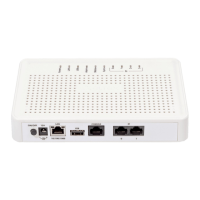54 SMG digital gateway
– Change dial plan —dialling the prefix allows the system to switch to another numbering
schedule. When this prefix type is selected, the New Numbering Schedule option becomes
available which allows selection of the numbering schedule to switch to.
For a trunk group:
TrunkGroup—the trunk group the call will be routed to by this prefix.
Direction—the trunk group access type: local, emergency, zone, private, long-distance,
international. It is used to limit communication capabilities if data communication with the
RADIUS server fails (see section 4.1.13 RADIUS Configuration).
Caller ID request—defines if transition to the trunk group specified in the Trunk Group field
requires caller ID information (caller number and category). When a call arrives from a
communication node and the caller ID information is missing, a caller ID request will be sent to the
node (an INR message from SS-7 signalling).
Caller ID mandatory—indicates that caller ID information is mandatory during the direction
transition. If caller ID information cannot be retrieved from the calling party, the connection
establishment is cancelled.
Dial mode—the method of number transmission:
– enblock—wait for collection of the entire address information;
– overlap—do not wait for collection of the entire address information.
Do not send end-of-dial (ST)—when checked, the end dial marker is not sent (ST in SS or "sending
complete" in PRI).
Priority—sets the prefix priority within the range from 0 to 100. A prefix with a smaller value has a
higher priority (0 is the highest priority, 100 is the lowest).
For trunk direction:
Trunk direction—a trunk direction (a set of trunk groups united in one direction), in which a call
will be routed by this prefix.
Direction—the trunk group access type: local, emergency, zone, private, long-distance,
international. It is used to limit communication capabilities if data communication with the
RADIUS server fails (see section 4.1.13 RADIUS Configuration).
Caller ID request—defines if transition to the trunk group specified in the Trunk Group field
requires caller ID information (caller number and category). When a call arrives from a
communication node and the caller ID information is missing, a caller ID request will be sent to the
node (an INR message from SS-7 signalling).
Caller ID mandatory—indicates that caller ID information is mandatory during the direction
transition. If caller ID information cannot be retrieved from the calling party, the connection
establishment is cancelled.
Dial mode—the method of number transmission:
– enblock—wait for collection of the entire address information;
– overlap—do not wait for collection of the entire address information.
Do not send end-of-dial (ST)—when checked, the end dial marker is not sent (ST in SS or "sending
complete" in PRI).
Priority—sets the prefix priority within the range from 0 to 100. A prefix with a smaller value has a
higher priority (0 is the highest priority, 100 is the lowest).
To change the numbering schedule:

